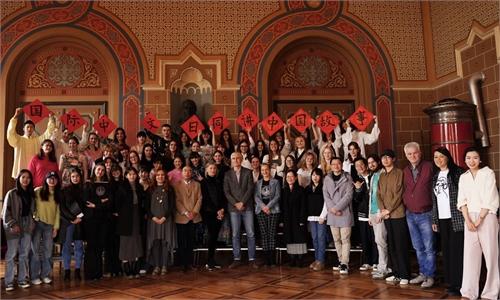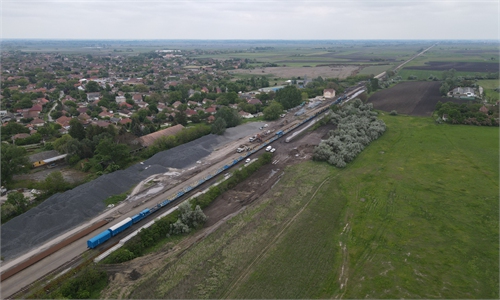BRI FOCUS / BRI IN DECADE
Stupendous changes
‘We will develop landmark BRI projects with high quality together with locals’
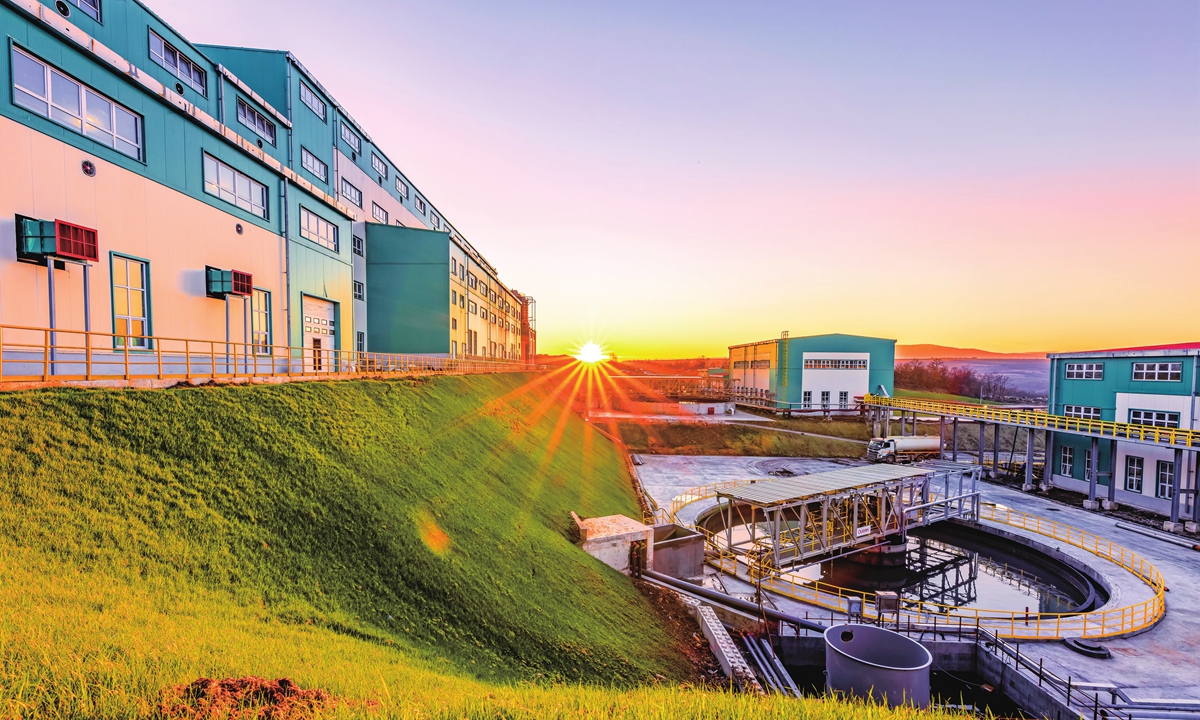
A whole view of the Zijin mine Photo: Courtesy of Zijin Mining Group
The sparkling blue Danube flows serenely across the Hungarian capital, Budapest, dubbed the Pearl of the Danube. In the territory of the Serbian capital of Belgrade, the Danube represents the heart of summer happenings.
Making its mark on cultures and civilizations, the Danube River is fundamental for Central and Eastern European countries (CEEC) and its importance as an international waterway is obvious.
Another important international waterway exists, known as the Maritime Silk Road. It stretches from East and South China toward Southeast Asia, South Asia, and then to East Africa, before finally reaching the East Mediterranean.
Since ancient times, blue and white porcelain from China passed through the Maritime Silk Road, then through the Danube River Basin, undergoing untold hardships and stormy seas before reaching the last stop in the living rooms and on the dining tables of Europeans.
Nowadays, the Danube River has become the witness of one cooperation project after another under the China-proposed Belt and Road Initiative (BRI), which comprises the Silk Road Economic Belt and the 21st Century Maritime Silk Road. In the eyes of locals, this cooperation has brought high-quality development and stupendous changes.
Endorsing ecological civilization
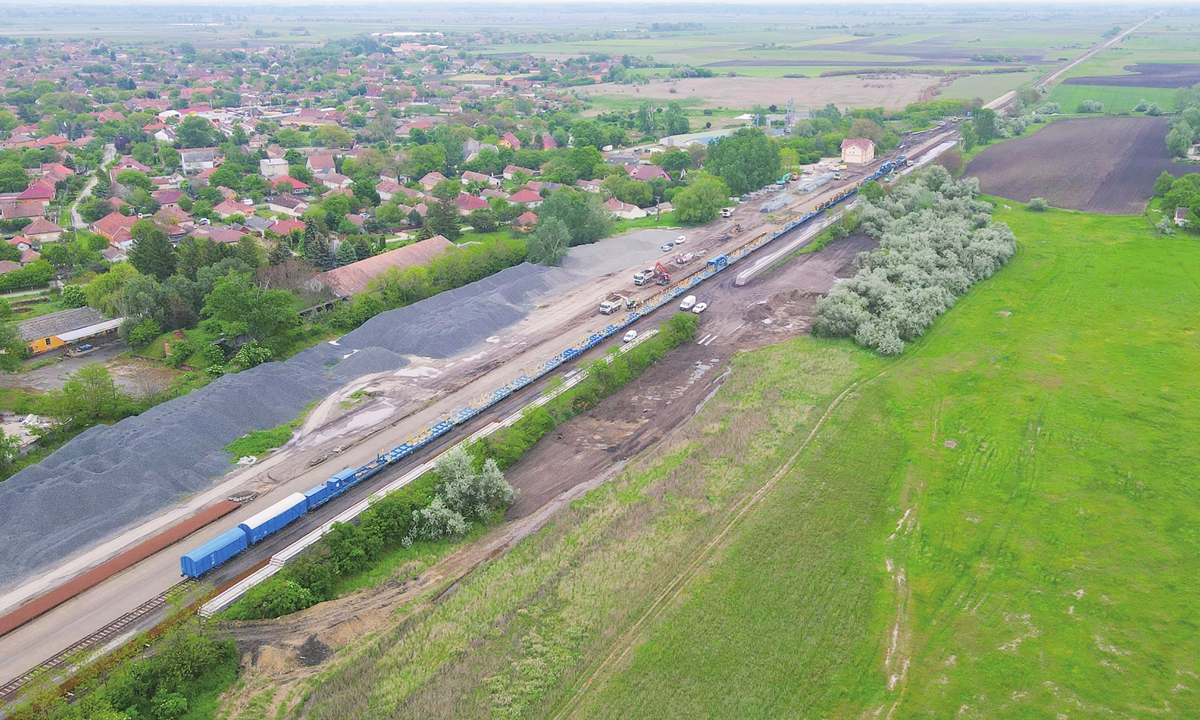
An aerial view of the construction scene of the Hungarian section of the Hungary-Serbia railway Photo: Courtesy of CREC
Only after working with Chinese colleagues did Hungarian engineer Kovacs Mate realize why China is proficient in infrastructure.
Kovacs joined the Hungary-Serbia railway project in August 2020. This line is a passenger and freight electrified railway that connects Budapest, considered a financial hub in Central Europe, and Belgrade, which occupies the central position of the Balkan Peninsula.
The project, contracted by a consortium that includes several subsidiaries of the China Railway Group Limited (CREC) and a Hungarian company, is a hallmark project of the BRI and represents the first case of Chinese railways extending to Europe. Once finished, the line will significantly reduce rail travel times between the two European capitals. Currently the Belgrade to the Hungarian border section is partially completed, while the Hungarian part is still under construction. At the station of Taksony, a town roughly 23 kilometers south of Budapest, Global Times reporters saw engineering vehicles efficiently undertaking roadbed construction work on the vast plains.
For Chinese builders, the biggest difficulty in the construction of the Hungary-Serbia railway lines isn't coordinating China's railway technology with the EU's technical standards for rail interconnection, but building local people's trust in China's ecological protection practices during the construction process, especially in Europe where environmental protection is highly prioritized.
"Hungary is an EU member state. Its environmental protection standards are very high and the requirements are extremely strict. If the environmental impact assessment does not meet these standards, the project will not be able to proceed to the construction stage," Li Yadan, deputy general manager of the Hungarian branch of CREC, told the Global Times.
From the time the contract came into effect to the start of the railway project, a significant amount of time was spent on design and environmental assessment work. The environmental impact assessment report for the Hungarian section not only needed approval from the Hungarian government, but also had to be reported to the European Commission for filing.
Chen Zhongliang, chief engineering officer at the China Railway No. 9 Group under CREC, participated in the compiling of the entire environment impact assessment of the railway. Over a period of 10 months, his team compiled a 1,300-page report with 168 data sheets and 90 pictures, which was eventually approved.
According to Chen, the report provides detailed guidance on various aspects, such as which times of the year cutting and construction are not allowed so as to protect the growth of local plants. It also stipulates which areas should be equipped with passages specifically for the migration of small animals, and during which period construction should be stopped to protect birds during the breeding season. Regarding noise detection, the report stipulates that data collected during pre-construction, construction, and post-construction should be compared to determine the impact on the area.
"There are more than 50 nature reserves along the construction line of the Hungary-Serbia railway, including bird habitats and water source reserves. For example, the railway will pass through the protected area of Hungary's national bird, the Great Bustard (Otis tarda). Therefore, we have adopted some protection measures in this project that other projects do not have. Some bird nests along the railway line were removed during the construction process and then moved back after completion," said Chen.
Song Ziwen, the project manager of the project branch of China Railway No. 9 Group, told the Global Times that through the implementation of the railway project, Chinese engineering and technical personnel have adopted more economical and effective environmental protection measures to minimize the impact of construction on the environment. At the same time, it optimizes the company's environmental protection costs.
A steel plant's rebirth
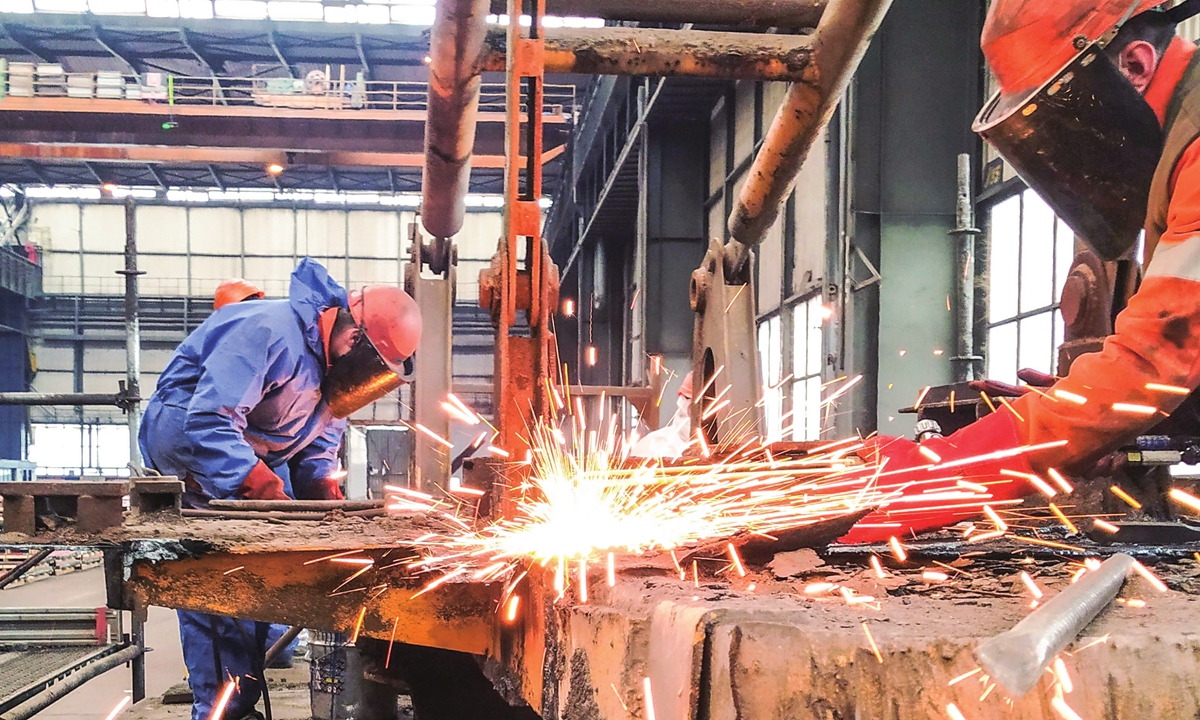
Two Serbian workers of HBIS Serbia, wearing protective masks, make steel in the plant. Photo: Courtesy of HBIS Serbia
Song Sihai has been working in Smederevo, a few hours' drive from Belgrade and an ancient Serbian city along the Danube River, for seven years. As executive director of HBIS GROUP Serbia Iron & Steel d.o.o (HBIS Serbia), owned by HBIS Group, based in Shijiazhuang, Hebei Province, Song has good reasons to be proud.
Back in 2016, HBIS acquired Zelezara Smederevo, Serbia's only steel plant, which had run into deep trouble due to poor management after the plant's former owner, US Steel, sold the mill to the Serbian government for a symbolic sum of $1 in 2012. Then Serbian prime minister Aleksandar Vucic, now the president, said that "talks with the HBIS Group are a top strategic priority for Serbia."
When HBIS eventually took the bold move, it was part of the Chinese company's "go global" strategy as well as part of the BRI cooperation between China and Serbia.
"There were domestic opposition voices," Song told the Global Times. "They asked, even a US company couldn't turn the tide, how could a Chinese company?"
A firm and strong will brought Song and several colleagues here. The first thing they did after the takeover was carry out comprehensive research into the basic condition of the plant, including the market, finance, logistics, equipment and environment policies. Song found that US and Western steel companies were not quite that good at cost control, while Chinese companies, which thrive in a competitive business environment in Asia, are better at cost control in both management and technology.
"The US steel company adopted the professional manager system, which enabled managers to have exceedingly high salaries and supporting conditions. This undoubtedly raised management costs. Meanwhile, they tended to appear superior. Unlike them, we treat locals as brothers and sisters," said Song, whose 59-year-old secretary, Dusanka Duda Rankovic, described him as the best boss she has ever worked for. Song shared a story of how HBIS saved on technological costs. During US Steel's management, it spent $20 million to dig a big pit to store zinc-bearing waste and dust. Each year, it had to pay an environment pollution fee to the Serbian government. Upon HBIS's takeover, the Chinese company had to dig another pit to deal with the waste as the first one was almost full. HBIS decided to conduct a thorough technological upgrade - cyclic utilization of zinc-bearing waste and dust after special treatment - and then use the resulting products for iron and steel smelting.
"Local staff opposed this plan at first, as they worried about the quality of the steel. We communicated with them patiently, and assigned technicians to test the quality of steel products. When they saw the quality was not affected and waste got recycled, they gradually came around," said Song.
The takeover has proven to be a success, as evidenced by the revival of the previously loss-making plant in the following year. It has now emerged as Serbia's second-largest exporter and achieved a record profit of 200 million yuan ($29 million). Before the acquisition, the Serbian government had to make up for the losses of the plant, which exceeded $100 million annually. But just last year, HBIS Serbia contributed 1.86 percent to Serbia's GDP.
The plant currently employs more than 5,000 Serbian workers, which is crucial for a country with a population of only 7 million. The family members of many employees work directly or indirectly for enterprises that provide supporting services. It means Zelezara Smederevo effectively supports one third of the population in Smederevo.
Among HBIS Serbian staff, there used to circulate a saying during hard times, "Every morning, if you see steam rise from the smokestacks, you know you still have a job." Now this is no longer a concern as the stability of having a working position is now assured.
"When you have a working position, you cannot say, 'Hey, I'm alone here with 5,000 other people.' No. You are part of one huge collective or one huge corporation. That is stability," said 43-year-old Dejan Dončić, who has been working for the plant for 20 years.
Going global
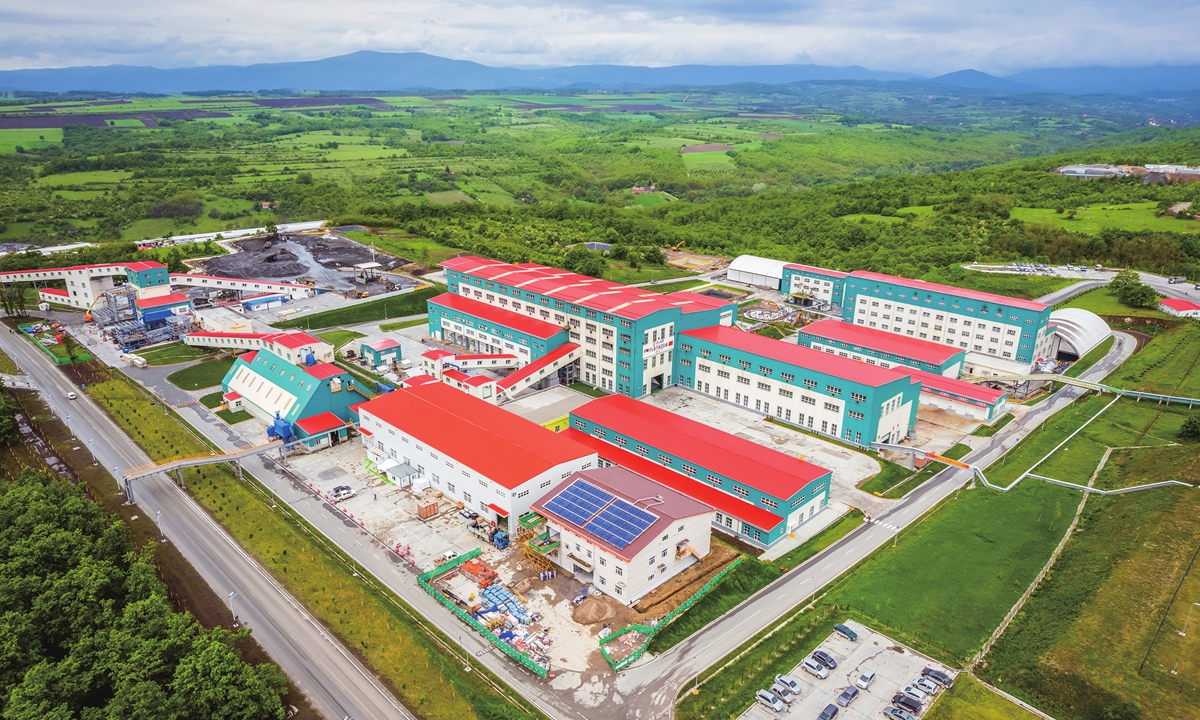
An aerial view of the working area of the Zijin mine Photo: Courtesy of Zijin Mining Group
The eastern Serbian city of Bor is well-known in Europe for its century-long history of copper mining. Its resource-rich mines, numerous chimneys, and workers pouring in from all directions were once symbols of Yugoslavia's economic prosperity. However, the fate of this mining city also followed the history of the Balkan Peninsula. After the Kosovo War, the Bor copper mine fell into a moribund time.
The Serbian government's determination to resolve the fate of the Bor copper mine as part of efforts to reform large public companies that had been piling up losses coincided with the Fujian-based Chinese company Zijin Mining Group's plan to follow the BRI to go global and expand business in BRI participating countries.
Serbia was one of the first countries to sign an MOU on BRI cooperation with China. In 2018, Zijin took a 63-percent share of RTB Bor, which later changed its name to Zijin Bor Copper, with an investment of $350 million.
Zijin fulfilled its promise of keeping the 4,900 workers at the company. In the past five years, it has recruited 2,700 new local staff members. With a population of only 50,000, Bor hasn't been able to meet the massive demand for workers, so the company has had to look to nearby areas in eastern Serbia. The upper core zone of Timok Mine was put into operation in October 2021. Within just two months, it entered the top 10 in terms of export volume.
The rapid development of mining has supported the Serbian economy. Currently, the mining industry accounts for 2.4 percent of Serbia's GDP. By June, Zijin had paid $528 million in taxes in Serbia.
When Global Times reporters visited the Zijin Timok mine, the surrounding area was filled with trees and fields of green. According to Su Yongding, deputy general manager of Serbia Zijin Mining, environment protection is always at the forefront of the company's mind during production. By June, the Zijin Bor Copper Mine had invested a total of $289 million in environment protection, and pollutants such as waste residue, gas, water and dust were effectively treated and discharged in compliance with local standards.
But still, like many other Chinese companies, Zijin also became the target of Western media. In 2021, a New York Times article titled "Serbia Hails Chinese Companies as Saviors, but Locals Chafe at Costs" accused Zijin of disturbing locals' lives by polluting the environment.
"We do have reports about some problems that occur. Sometimes they are real problems, sometimes they are fabricated. I think that the general public has the knowledge and understanding of these problems. When they see the information, they know from which side it is coming, they can judge by themselves," Katarina Zakic, head of the Regional Center "Belt and Road" in Belgrade, told the Global Times.
Zijin takes an open approach toward Western and local media and NGOs. It wants to tell its story, and tell its story well.
"It's been many years since Chinese companies have gone global. After years of struggle and hard work, they have gained a deeper understanding of international rules and standards. Zijin is endeavoring to adapt to the rules and act positively," said Su.
Each year, Zijin holds an open day for media and takes journalists to the mines and answer questions from them. At the end of each year, Zijin also invites journalists for a gathering to deepen communication. Wen Hongzhi, office director of Zijin Bor Copper, told the Global Times that they are learning how to communicate with local media and NGOs in a way that they understand. He also admitted that there are NGOs which refuse to talk to them and go to great lengths to avoid engaging with them.
This doesn't stop Zijin from shouldering more social responsibilities. It has taken up several schemes. One is a scholarship program which provides an annual fund of $700 per person to 100 middle school students in Bor. Another is giving books to primary school kids. Zijin has also spent more than 1 million euros to renovate water pipelines to solve the problem of substandard quality of local drinking water.
"We hope to not only provide job opportunities, but also let communities share the dividends of the company's development and engage with them," said Wen.
'Divide and rule' - demonizing China

The Hungarian Parliament Building in Budapest, Hungary Photo: VCG
The way Chinese companies have engaged with local regions is a microcosm of the overall Chinese approach toward CEEC through the implementation of the BRI. During the third China-CEEC Expo & International Consumer Goods Fair in Ningbo, East China's Zhejiang Province, in May, Wang Yong, vice chairman of the 14th National Committee of the Chinese People's Political Consultative Conference, said that China will continue to promote the high-quality development of the BRI to constantly unleash the potential of China-CEEC cooperation.
Sun Keqin, a research fellow at the China Institutes of Contemporary International Relations, suggested several approaches with which China can stabilize and develop cooperation with CEEC. He said that when Chinese companies face groundless slander, they should safeguard their rights through legal means rather than sitting still. They should research local laws and regulations, including those of the EU, and operate within the legal framework. They can also conduct third-party cooperation with EU countries and share the benefits.
Chinese companies should oppose certain forces in the West who politicize their normal trade and economic relations with host countries, and oppose their attempts to isolate Chinese companies by using geopolitical excuses. Meanwhile, as Chinese companies help with local employment and taxes, they should use the bond between the companies, employees and local governments to safeguard their joint interests, Sun told the Global Times.
While the BRI focuses on transport and energy infrastructure such as roads, railways, ports, and power plants, some foreign observers often interpret it as a means for China to establish influence or even "divide and rule" the EU. Levente Horváth, founding director of the Eurasia Center of the John von Neumann University, Hungary, and consul general of Hungary in Shanghai between 2015 and 2017, believes that this "is just demonizing China."
"In the new world order, we have come to realize that Western countries are not entirely pleased with the changing global dynamics. They are demonizing China and are not very keen on the idea of establishing strong connectivity between Europe and Asia. Nevertheless, the China-CEEC cooperation goes beyond being a simple cooperation platform. It represents an opportunity to engage in cooperation with China," Horváth told the Global Times.
"As we have come here, we want long-term engagement, instead of simply being passers-by or wining some compliments. We will develop landmark BRI projects well with high quality together with the locals," said Song Sihai, executive director of HBIS Serbia.

